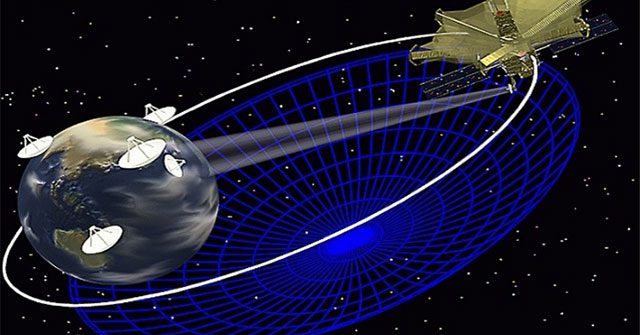China is set to launch a lunar orbiting observatory to create a radio telescope with a diameter of 400,000 kilometers.

Simulation of a Very Long Baseline Interferometry network in space. Image: NASA
The new radio telescope will be constructed in two phases and is expected to be operational within two years. First, a communication relay satellite for China’s Chang’e 7 mission will be launched and transformed into a lunar orbiting observatory. Subsequently, several ground-based observatories will join the project named the Very Long Baseline Interferometry (VLBI), forming a massive antenna network that technically equates to a radio telescope nearly 400,000 kilometers wide. In comparison, the largest single-dish telescope in the world is the Five-hundred-meter Aperture Spherical Telescope (FAST) located in China.
It is anticipated that the VLBI project will be launched before 2025. This will be the largest equipment facility ever created for astronomical observation. The system could provide images of significant astronomical phenomena such as black holes and gravitational lenses with unprecedented resolution in the X-ray spectrum.
Theoretically, a telescope extending from Earth to the Moon could capture images of events occurring during a rugby match on Mars. The greater the distance between two observatories, the higher the resolution of the images. The method of combining several smaller telescopes to create a larger device is known as Very Long Baseline Interferometry (VLBI), which was invented in the 1950s. The first image of a black hole was produced in 2019 by the Event Horizon Telescope, a VLBI network that utilized observatories worldwide to achieve a diameter equivalent to that of Earth. Both Russia and Japan have previously launched satellites to extend the range of VLBI observations beyond Earth, but were unable to reach as far as the Moon.
However, the project raises some questions regarding its feasibility. To operate as a telescope, data collected from various locations must be precisely timed. This requires a type of atomic clock known as a hydrogen maser (a device that generates and amplifies electromagnetic radiation primarily in the microwave region of the spectrum), which can operate for extended periods with extremely high stability. However, size and weight limitations mean that the accuracy of hydrogen clocks on satellites often falls short of larger machines on Earth. Researchers are uncertain whether the small observatory in lunar orbit can function consistently.
In a study published on March 28 in the journal Acta Astronomica Sinica, a research team led by Professor Liu Qinghui at the Shanghai Astronomical Observatory stated that atomic clocks are not a major issue. They reached this conclusion based on recent experiments with Tianwen-1, China’s spacecraft orbiting Mars. Liu and his colleagues monitored extremely weak signals from Tianwen-1 using hydrogen masers developed for the telescope program. They found that the small atomic clocks and the larger versions on Earth differed much less than expected.
If the project proceeds as planned, China will launch additional satellites and establish fixed observatories on the Moon or even Mars to create an interplanetary telescope.





















































